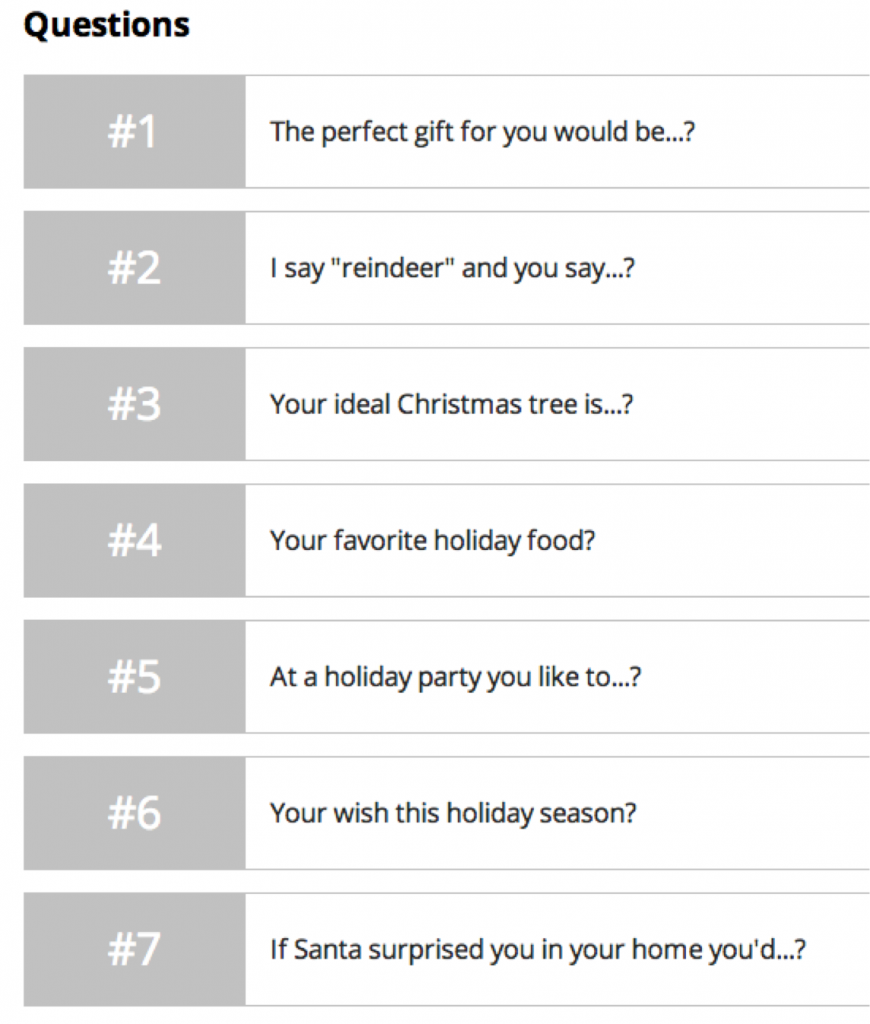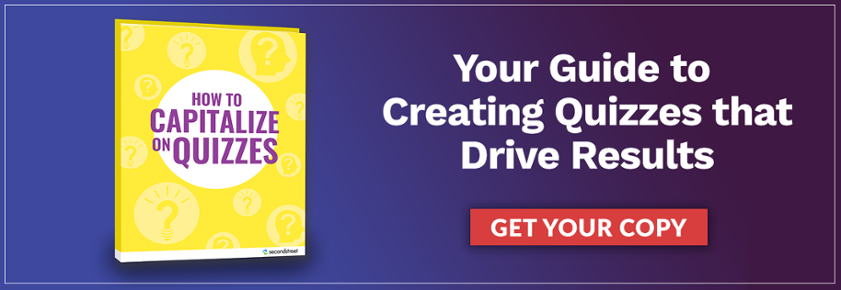Have a great topic – and title – for which you are passionate
There are a lot of distractions on the Internet, so you’ll want to make sure your quiz stands out.
If the title of the quiz makes people smile, you have a winner you can run any time of the year. If the topic is timely, you’ll have a winner for a particular season. If you combine the right title and the right time and add a sponsor, you’ll hit a home run (my What Holiday Movie Are You? quiz could be sponsored by a local movie theater, bank, hospital, retailer, etc.).
Lastly, it’s important to be knowledgeable about the topic of the quiz you are creating. If you don’t know much or aren’t passionate about it, I suggest you find an expert to work on the quiz with you.
Get your copy of our Quiz Playbook for tons of quiz ideas and case studies »
Write questions that are fun to answer
When I’m writing questions for my quizzes, I use my 16 year old daughter as my litmus test. I watch her read the questions, and if she doesn’t smile, I throw the question out. I want people to have fun with them, and since teenagers see so much baloney online all day long, it takes a lot for her to actually be engaged. If I get a smile, I know I hit a home run.
The holiday movie quiz above you took is version 9. Not version 1. My daughter thought the first 8 versions were BORING, and I listened.
Here are a few other tips:
- The ideal number of questions is 7. With fewer than 7, the quiz doesn’t seem like much of an experience. It goes too quickly. More than 7 questions often feels like a drag to me. I try to come up with at least 14 questions, so the 7 I end up using are my best 7 rather than my only 7.
- The most important questions are #1, #2, #3, and #7. The first 3 questions will grab the user’s attention, and if they love those then they are hooked and will finish the quiz. The last question is the crescendo, and you want to go out with a bang. See what I mean with these questions for my holiday quiz:

Remember people are looking for themselves in the distinct answers
People who take your quiz are quickly looking for the answer that best represents them, so put a lot of thought into getting these right.
- The ideal number is 4. If you have 4 answers, on a computer they line up nicely in one row and on a phone they line up nicely stacked 2 over 2. It looks clean like this, and the consistency works well for the user and helps them get into a rhythm. However, if you are using images in your answers then you can get away with a lot more options.
- Provide a distinct spectrum of answers. I hate taking quizzes where two answers are incredibly close to each other. I think it is best when they are uniquely different and cover the full spectrum so everyone has one that works for them. I use a strategy of high, medium, low, and no interest. One answer will be extremely extroverted, one average, one mild, and one for someone with no interest in the topic at all. Here is a set of answers that cover the spectrum – a main dish, sides, dessert, and something else:

- Keep it short. One word answers are the best. The next best is a 2-4 word phrase. If you do have to write a longer answer, make just one answer in the set like that, and make it the last answer so it doesn’t slow the user down.

- Vary the punch line. Sometimes put the funny answer at the end. Sometimes lead with it, like I did with this question:

- The best answers include photos. Pictures say a thousand words! High-quality images (that are legally approved) are the Holy Grail of a good answer set.
Limit your outcomes to ones people are so excited to get that they share
If they are taking a “What Baseball Player Are You?” quiz, people want to get a player they know. You don’t want to get back a late inning substitute outfielder. You want the quiz to tell you you’re a superstar.
Plus, as with answers, the best outcomes will include high-quality images.
- The ideal number is 6 to 9. The more outcomes you have, the harder it is to spread the weights amongst the answers to ensure all of the outcomes have a chance.
- Make them distinct. You want to make sure you have a full spectrum in your possible outcomes. In the holiday movie quiz, Elf and Scrooged are on opposite ends of the outcome spectrum. They are both comedies, but the lead in Elf is pro-Christmas while the lead in Scrooged is anti-Christmas. That makes differentiating between them a lot easier.
- Add a positive description. Don’t just give the name of the outcome at the end. Take the time to provide a “fortune” that goes with it that quickly explains why they got that outcome. For example: “Elf. You love, love, love like the holidays.” Remember the better your descriptions, the happier your users will be; and that be the difference between them sharing their outcome or not.
Make sure all your outcomes are possible
If you are having trouble assigning scores to outcomes it is probably because the tips above were not fully considered. Here’s an analogy:
Once I got a golf lesson in how to putt. The instructor watched me take a few putts and then he said, “Actually, let me see you chip.” So I walked several yards away from the green and hit a few chips. And then he said, “You know what your problem is with putting? Nothing. It’s your chipping. Your putting is fine but your chipping puts you so far away from the hole that it makes all your putts harder. You want to be a better putter? Become a better chipper.”
If you want want to make assigning points to outcomes easier make sure you have good outcomes that are distinctly different from each other and you don’t have too many of them. Also, make sure your answers cover the spectrum of high, medium, low, and no interest. Basically if you follow the best practices of questions to ask, available answers, and distinctly different outcomes then assigning weights is a piece of cake.
Here’s how to use the “Check Quiz Balance” tool to equally weight your outcomes when you’re making a quiz on our platform:
- Generally limit weights to a value of 1 or 2. I only assign a weight of 5 if a response really points to a certain outcome. For example, if the user picks something that correlates to “singing Christmas carols as loud as possible to all that can hear”…well, that sounds a lot like Buddy the Elf to me.
- Make all the outcomes possible. The most important thing “Check Quiz Balance” does is make sure all the outcomes are at least possible. It’s OK if they are not all equally weighted, but they should all be possible.. If you were doing “What Star Wars Character Are You?”, would you expect an equal number of people to be Han Solo and Darth Vader? It’s OK if Darth Vader is harder to get, but you don’t want to make it impossible to end up as him.
The best way to make sure it is balanced, though, is to eventually get a bunch of friends, family, and coworkers to play your quiz. Then look at the actual results in the dashboard and tweak it from there.

In Closing
Have fun making quizzes! If you consider these 5 tips, you’re sure to build a viral winner.
After you make your quiz, feel free to share a link in the comments. We’ll be happy to play it, and if you desire, give you some feedback.






